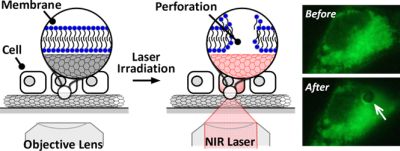|
|
|
|
|
TSUKUBA, Japan, Aug 15, 2014 - (ACN Newswire) - Japanese researchers have developed a new, targeted method for perforating cell membranes in order to deliver drugs to, or manipulate the genes of, individual cells. The paper is published in the journal Science and Technology of Advanced Materials.
 | | Carbon nanotubes and near-infrared lasers promise a cost effective solution for cell membrane manipulation |
The method involves the near-infrared (NIR) laser irradiation of a thin film of carbon nanotubes, which act as an effective photon absorber as well as a stimulus generator.
In cell engineering and tissue biology research, the use of pulsed lasers to stimulate cells has emerged as a powerful technique for enabling selective gene transfection, drug injection or the regulation of gene expression. The irradiation of biological cells using pulsed lasers causes their membranes to perforate, which significantly accelerates gene transfection or the targeted delivery of drugs.
Among the wide range of photon energies, the near-infrared region is less harmful for biological cells, which absorb very little energy in these wavelengths. The most successful NIR lasers are femtosecond lasers due to their fine spatial resolution with no thermal or mechanical damage to surrounding materials. But femtosecond laser instruments are expensive and require a highly sophisticated optical arrangement and much space, so the research team opted for a more economical nanosecond laser.
In the study, Naotoshi Nakashima and colleagues at Kyushu University used a dish coated with single-walled carbon nanotubes (SWCNTs), which strongly absorb radiation in the NIR region, as an antenna for a nanosecond pulse laser. The team found that cell membranes were either reversibly or irreversibly disturbed following an NIR pulse, depending on the energy of the laser. When a pulse exceeded 17.5 microJoules, the membrane was irreversibly disrupted and the cell died. By contrast, at about 15 microJoules per pulse, the membrane opened and the cell remained alive. This suggests an inexpensive laser source could be used to prepare a single cell target for selective gene transfection, drug injection or regulation of gene expression, the authors conclude.
The paper is available for download: http://iopscience.iop.org/1468-6996/15/4
For further information contact:
Naotoshi Nakashima
Department of Applied Chemistry
Graduate School of Engineering
Kyushu University
744 Motooka Nishi-ku, Fukuoka 819-0395, Japan
Email: nakashima-tcm@mail.cstm.kyushu-u.ac.jp
Press release distributed by ResearchSEA for National Institute for Materials Science.
Topic: Research and development
Source: National Institute for Materials Science (NIMS)
Sectors: Science & Research, BioTech
https://www.acnnewswire.com
From the Asia Corporate News Network
Copyright © 2025 ACN Newswire. All rights reserved. A division of Asia Corporate News Network.
|
|
|
|

|
|
|
|